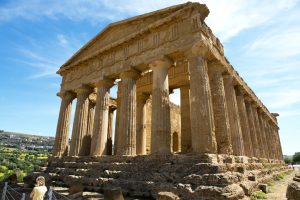The following article, written by ISDA President Basil Russo, was first published in La Nostra Voce.
More Italian immigrants came to America from Sicily than from any other region of Italy.
Frank Sinatra, Joe DiMaggio, Joe Montana, Lady Gaga, Al Pacino, Antonin Scalia and Liza Minnelli are but a few of the hundreds of children of Sicilian immigrants who became major celebrities, and helped to define the American landscape.
La Nostra Voce felt it was important to explore the major regions of Italy where our ancestors came from. We begin by examining the history, culture, traditions and cuisine of the fascinating island of Sicily.
History: Because of its strategic location in the Mediterranean Sea, Sicily, for over 2,500 years, has remained a significant crossroad of the western world.
Sicily has been occupied by the Phoenicians, Greeks, Romans, Byzantines, Arabs, Normans, French and Germans before it became an important region of the Republic of Italy.
Sicily initially became part of Italy in 1860, following the Expedition of the Thousand, a revolt led by Giuseppe Garibaldi during the Italian unification. Sicily was later given a special status as an autonomous region after the Italian constitutional referendum of 1946.
The history of Sicily is very similar to that of the United States, in that just as people from throughout the world brought their customs, traditions, values and cuisine with them to the U.S. to form a uniquely American culture, so too was the same for Sicily to help form a uniquely Sicilian culture.
This multi-cultural impression offers visitors the opportunity to experience Greek temples, Roman villas and aquaducts, Norman cathedrals and Baroque churches. Such a mixture is rare in this, or any part of the world.

Population and Geography: Sicily currently has about 5 million people residing on the island, and it is roughly the same size as the state of Massachusetts.
The largest cities in Sicily are Palermo and Catania, with populatiions of 870,000 and 572,000, respectively.
The island is made up of hundreds of small towns and villages, many of which are located along the sides and tops of mountains, which occupy much of the island.
The largest mountain on the island is Mt. Etna, which is 10,922 feet in height, and is western Europe’s largest volcano. Although Etna has erupted frequently in recent years, it has caused little damage to the surrounding area.

Food and Wine: Due to the influence of so many foreign cultures and peoples, Sicily has a very impressive culinary history of notable foods and wines.
The following foods are uniquely Sicilian: Pasta alla Norma (pasta with eggplant), Caponata, Arancini, Pecorino and Caciocavallo cheeses, and many great desserts including Cannoli, Casata Cake, Sfingi and Granita.
Wines unique to Sicily are: Marsala, a fortified wine with a 20% alcohol content; Muscato, a sweet dessert wine; and Nero d’Avala, a hearty red wine.

Arts and Literature: Sicily has a rich and extensive history in both the arts and literature. Palermo is home to the largest opera house in Italy, Teatro Massimo.
Some of Italy’s most noted poets and writters were Sicilian. They include Nobel laureates Luigi Pirandello and Salvatore Quasimondo, and novelist Giuseppe Tomasi de Lampedusa, author of Il Gattopardo (The Leopard).

Popular Culture: Every Sicilian city and town has its own patron saint around which it plans a festival each year marked by colorful processions throughout the town, with marching bands, towns people in traditional costumes and fireworks. Sicilians also enjoy outdoor festivals in the towns main piazza with food, live music and dancing.
Another unique Sicilian tradition is the Opera dei Pupi (Opera of the Puppets), which is a theatrical performance of marionettte puppets, dating back to the 13th century.

Conclusion: Sicily is an extraordinary island with a rich and complex history from which so many of our members trace their ancestral roots.
This article first appeared in La Nostra Voce, ISDA’s 28-page monthly newspaper, which chronicles Italian life, culture and traditions. Make the ISDA pledge and subscribe today.


